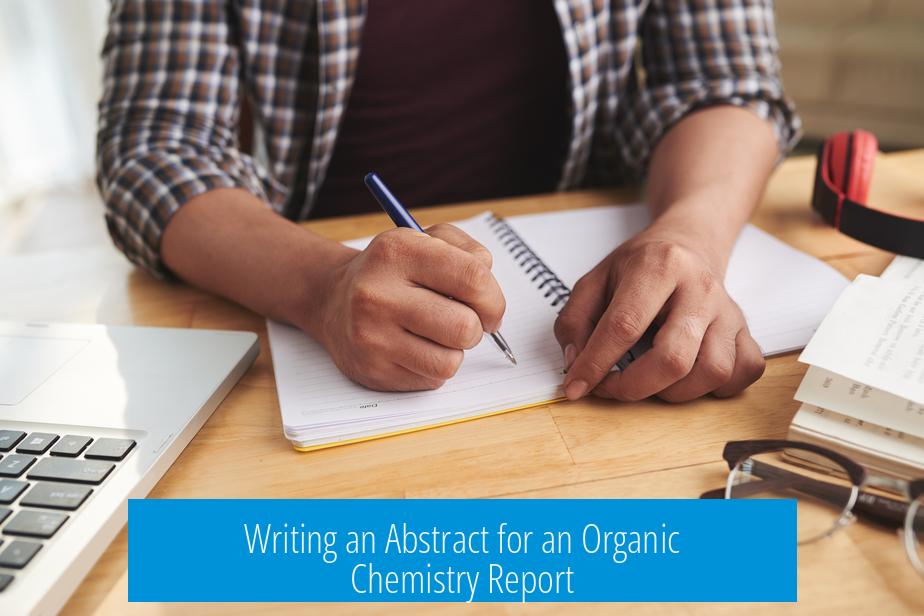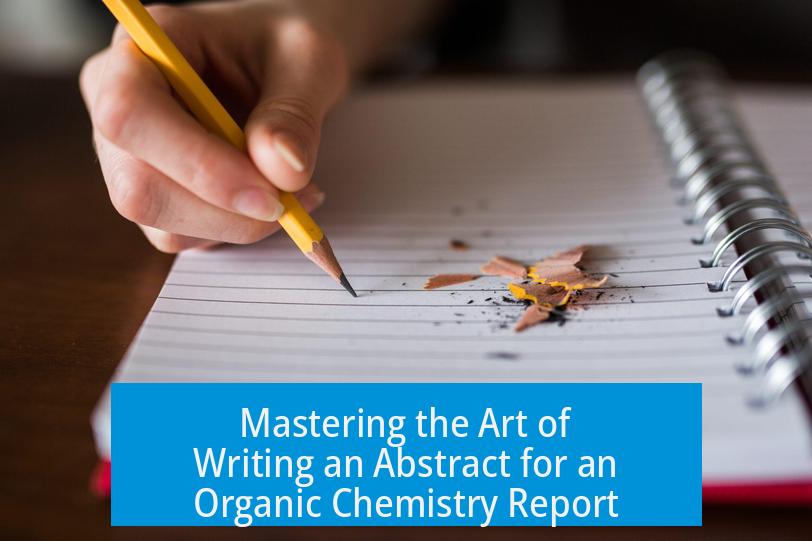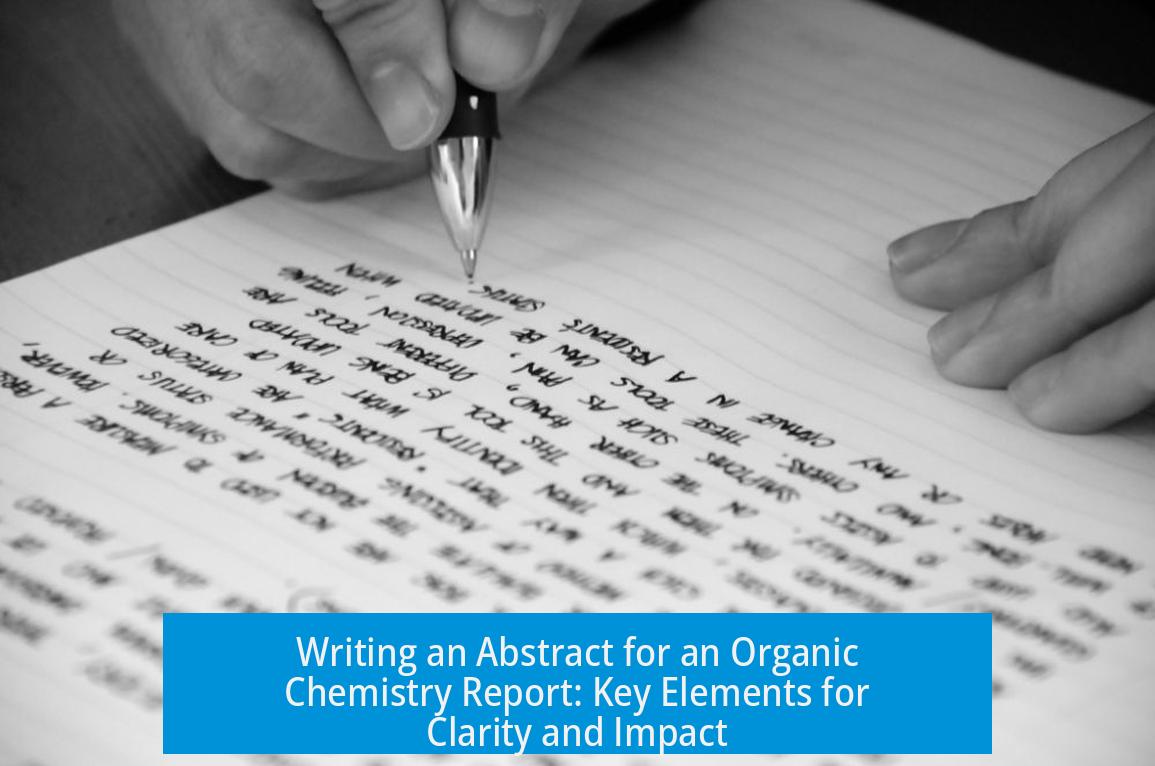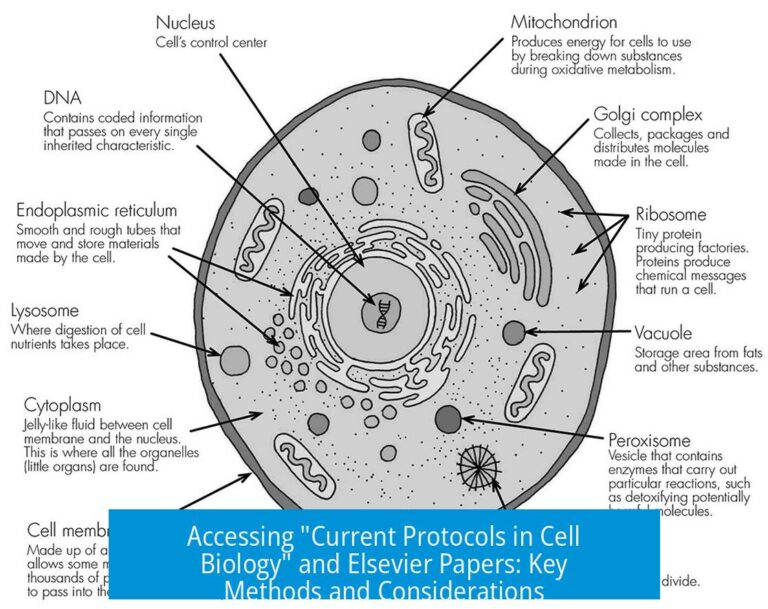Writing an Abstract for an Organic Chemistry Report

An abstract for an organic chemistry report succinctly summarizes your experiment, highlighting the reaction scheme, method, results, and conclusions in a clear, concise paragraph. It acts as a snapshot of your entire study, guiding readers to understand your work quickly.
Content Requirements
The abstract must include the overall reaction scheme with a labeled figure, typically titled “Scheme 1” or similar. Below the figure, provide a brief summary that explains how the reaction functions. Include essential experimental details such as the method or procedure, the percent yield obtained, and if applicable, the Rf factor from thin-layer chromatography.
This section also needs to present the purpose of the study, the main experimental results, and key conclusions. Summarize major techniques and critical data to ensure completeness and clarity in a concise manner. The abstract should focus on delivering this information without unnecessary detail or over-explanation.
Figure Labeling
Label your reaction scheme clearly within the abstract. Use direct references such as “(Scheme 1)” so readers know precisely which reaction you discuss. When mentioning the figure, simply refer to the labeled scheme to maintain clarity and avoid redundancy.
Length and Structure
Write the abstract as a single paragraph, roughly 150 to 250 words and about 2–5 sentences, depending on the course or journal guidelines. Despite minor variations between settings, the brevity and clarity of an abstract remain essential. Focus on summarizing without sacrificing essential content.
Purpose and Audience

Your abstract serves as a brief overview, stating the problem addressed by your experiment, the methodology applied, and the findings obtained. Readers should understand the main objectives and outcomes from your abstract alone without consulting the full report.
Importance of Quality
A polished and professional abstract reflects the relevance and rigor of your research. It invites readers to explore your full report by making your study’s contribution clear and compelling.
Practical Tips
- Follow your professor’s or journal’s specific guidelines when available.
- Post drafts of your abstract for feedback to improve clarity and correctness.
- Keep technical jargon minimal but precise to cater to a broad scientific audience.
Key Takeaways
- Include a clearly labeled reaction scheme in the abstract.
- Summarize the purpose, methods, major data, and conclusions concisely.
- Maintain a brief length, typically 150-250 words in a single paragraph.
- Use clear figure labels like “Scheme 1” for easy referencing.
- Ensure the abstract is polished to reflect the significance of your work.
Mastering the Art of Writing an Abstract for an Organic Chemistry Report

Ever stared at a blank screen, wondering how to shrink days of complex organic chemistry lab work into a neat paragraph? You’re not alone. Writing an abstract for an organic chemistry report may seem like a daunting task, but it’s your golden opportunity to showcase the core of your experiment quickly and effectively.
Here’s the simplest way to nail it: An abstract isn’t a lecture, nor a novel. It’s a snapshot — a clear, concise summary that tells readers what you did, how you did it, and what you found out. But in organic chemistry, it comes with a few special ingredients.
Clear and Compact: What to Include in the Abstract?
First off, you need to think like a detective. What did your reaction actually do? How did it work? The backbone of your abstract is the overall figure or scheme of the reaction.
Imagine this: you put your reaction scheme right at the top of your abstract. It would be labeled “(Scheme 1)” or something similar. Why? To give your reader a visual anchor before diving into words. Just mentioning “Scheme 1” in your text links the reader’s eyes to the exact reaction without confusion.
Underneath the scheme, slide in a succinct summary. Here’s what your abstract really needs:
- How the reaction mechanism works – What’s the chemistry behind it?
- Method used – Simple mention of the process or technique applied.
- Percent yield – Your result’s success rate isn’t just a number; it’s evidence of your experiment’s efficiency.
- Possible Rf factor – Including Rf adds an analytical touch if chromatography was part of your work.
This combination packs a factual punch, satisfying any chemist’s curiosity without making them scroll through pages.
How Long Should It Be? Short and Sweet Wins
Keep it tidy. Your abstract typically fits within 150 to 250 words – about 2 to 5 sentences in length. Enough to deliver key information but not enough to bore your reader. Remember, your reader is scanning, not skimming a novel.
One well-structured paragraph does the trick, focusing on major experimental steps and your crucial findings. Fancy jargon? No thanks. Clarity rules here.
The Purpose Behind the Abstract: Why Bother?
An abstract answers the “So what?” question right upfront. It clarifies the goal of your experiment, the techniques you wielded like a lab ninja, and what you discovered along the way. Essentially, someone scanning your report should grasp your entire project from the abstract.
Think of it as your experiment’s elevator pitch – short and powerful. Your success in describing your work here will likely decide if the reader dives deeper into your full report.
Labeling Figures: The Secret Sauce of Clarity

Don’t forget the little things matter. Label your reaction scheme clearly – as “Scheme 1,” “Scheme 2,” etc. This is more than just formalities; it links text and visuals smoothly. When mentioning your figure, simply refer by label. No need to re-explain the figure every time.
This kind of neat referencing keeps your abstract polished and professional, not to mention easier to follow.
Common Concerns: What if My Professor Didn’t Give Clear Guidelines?
No stress. For many undergraduate organic labs, especially in Ochem 1 or 2, rigid formatting might not exist. You still want to follow best practices, but you can be flexible.
Focus on making your abstract informative first. Then, seek feedback from peers, TAs, or online chemistry forums. Posting your abstract online for critique can improve clarity and catch errors you might miss.
Real Talk: Why Bother Polishing Your Abstract?
A polished abstract signals your research is worth a glance—and maybe a deep dive. It boosts your credibility and helps others quickly judge relevance to their work.
For journal submissions or advanced research, a sloppy abstract might mean a missed opportunity. For class reports? It still reflects your professionalism and attention to detail.
Practical Tips for Writing Your Abstract
- Start by drafting the reaction scheme first. Visualize your entire reaction.
- Write a few sentences covering each core point – mechanism, method, yield, Rf factor.
- Use active voice. “The reaction proceeded via…” beats “The reaction was proceeded via…” any day.
- Keep jargon minimal and explain when necessary.
- Use precise numbers like “Yield was 78%” rather than vague “good yield.”
- Get feedback before finalizing. Your fresh-eyed friends will spot confusing parts.
Final Thought: What Makes an Abstract Stand Out?
It’s not just completeness or brevity. It’s how effortlessly your abstract lets the reader see the heart of your experiment. Being concise without skipping important details is the sweet spot.
So, next time you face the blank screen, remember: include your reaction scheme, summarize the key steps efficiently, state your results clearly, label everything well, and keep it brief. Your abstract will not just inform—it will engage.
Don’t underestimate the power of a well-crafted abstract. It’s your first impression, your showcase. Nail it, and your organic chemistry report suddenly feels a lot less scary.
What key elements must be included in an organic chemistry abstract?
Include the overall reaction figure, a brief experiment summary, how the reaction works, method used, percent yield, and possibly the Rf factor. State the purpose, main results, and conclusions clearly.
How should figures be labeled in an organic chemistry abstract?
Label figures clearly, such as “(Scheme 1),” so readers know which figure you refer to. Mention this label in the abstract text to connect the figure and description.
What is the typical length and structure of an abstract for this type of report?
Abstracts are usually 2–5 sentences long, around 150–250 words. They should briefly summarize the study without going into extensive detail.
Why is it important to write a polished abstract for an organic chemistry report?
A polished abstract shows the relevance of your research. It helps readers quickly grasp the work’s purpose and significance, making your report more professional.
Can the abstract requirements vary depending on course or journal?
Yes, requirements can differ. For class labs, restrictions might be fewer. Always check your professor’s or journal’s guidelines before writing.





Leave a Comment